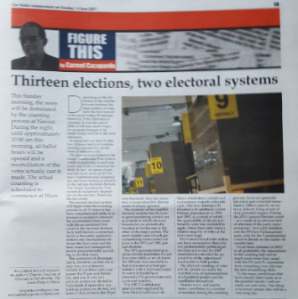Il-vot li għandu kull wieħed minna hu b’saħħtu ħafna: ferm iktar milli naħsbu. Fis-sistema elettorali tagħna il-vot hu trasferibbli: jgħaddi mingħand kandidat għall-ieħor. Dan minħabba li aħna nagħmlu użu minn sistema ta’ preferenzi, waħda wara l-oħra. Is-sistema elettorali tagħna fil-fatt tissejjaħ single transferable vote (STV), vot singlu transferibbli.
Dan ifisser li aħna nibdew billi nagħtu l-ewwel preferenza lill-kandidat li nippreferu. Wara nkomplu nagħtu iktar preferenzi lil kandidati l-oħra. B’hekk il-vot tagħna, jekk ikun hemm waqt li ma jkunx qed jintuża mill-kandidat preferut tagħna, jkun jista’ jgħaddi fuq il-kandidat li jkollu it-tieni preferenza. Jekk ikun hemm bżonn imbagħad il-vot jibqa’ jintiret minn min ikollu preferenza iktar l-isfel ukoll. Hekk jiġri fl-elezzjonijiet kollha li jsiru f’dan il-pajjiż.
Imma mhux kulħadd jagħmel użu mill-preferenzi wara l-unu bl-istess mod. Hemm min jagħti preferenzi lil kandidati ta’ partit wieħed biss u jinjoraw lill-bqija. Hemm min jinjora anke parti mil-lista tal-partit li jappoġġa. Hi għażla li issir minn kull votant: għażla li jagħmlu bi dritt.
Hemm min, min-naħa l-oħra, ma jagħtix preferenzi lill-kandidati ta’ partit wieħed biss, iżda, wara li jagħżel il-kandidat jew kandidati preferuti tiegħu jagħżel ukoll lil dawk li jidhirlu li huma l-aħjar fost il-bqija u jagħtihom preferenza ukoll, skond kif jidhirlu li hu xieraq. Billi l-vot jgħaddi mingħand kandidat/i ta’ partit għal għand kandidat/i ta’ partit ieħor insejħulu “cross-party voting”.
Il-partiti l-kbar ma jaqblux mal-“cross-party voting” għax dan il-mod ta’ kif tivvota idgħajjef is-saħħa tagħhom. Fil-fatt huma jiskuraġixxu lil dawk li jappoġġawhom biex jevitaw il-“cross party voting”. F’kull elezzjoni l-partiti l-kbar u l-kandidati tagħhom ifesfsu u jgħidu fil-widnejn li jekk il-vot iħallat kandidati minn partiti differenti, ikun ħażin u ma jgħoddx. Jagħmlu dan biex inaqqsu t-telf possibli ta’ voti tagħhom bejn għadd u ieħor. Aħna bħala ADPD min-naħa l-oħra dejjem inkoraġġejna lill-votanti li possibilment jivvutaw u jagħtu valur lil kull kandidat li jkollhom quddiemhom. Għax hu b’dan il-mod li nistgħu bħala pajjiż ikollna l-aħjar rappresentanti.
Fil-fatt hemm numru mhux żgħir minn dawk li jivvutaw lill-ADPD li jkomplu l-vot tagħhom fuq partiti oħra. Il-persentaġġ ta’ dan ivarja minn elezzjoni għall-oħra. Ivarja anke bejn distrett u ieħor jew lokalità u oħra. Għalkemm hu persentaġġ li jvarja pero ġeneralment ikun madwar it-33 fil-mija: jiġifieri wieħed minn kull tlett votanti li jagħtu l-vot tagħhom lill-ADPD, wara, jkomplu fuq kandidati ta’ partiti oħra. Mhux l-ewwel darba, f’elezzjoni akkanita, li dawn il-voti iddeterminaw min jitla’.
Dan hu tajjeb u juri kemm hu b’saħħtu l-vot individwali. Hu mod matur kif tintuża s-saħħa tal-vot u kif ikun assigurat li l-vot jibqa’ effettiv l-iktar possibli tul il-proċess elettorali. Dan kollu għandna mhux biss nirrispettawh: fuq kollox għandna ninkuraġġuh għax jagħmel il-ġid lill-pajjiż.
Qed ngħid dan fid-dawl tal-kandidatura tiegħi għall-elezzjoni każwali li ser issir għada it-Tnejn 14 ta’ Novembru 2022 wara li Albert Buttiġieġ irreżenja mill-Kunsill Lokali ta’ San Ġiljan, in vista tal-elezzjoni tiegħu bħala Membru Parlamentari.
Nhar l-Erbgħa li għaddew tfajt in-nominazzjoni tiegħi b’rispett lejn kull votant, b’mod partikolari dawk li ma jħossuhomx ristretti dwar kif għandhom jivvutaw. Bħala partit politiku, l-partit li jiena mmexxi dejjem saħaq li l-vot hu b’saħħtu biżżejjed biex jintuża lil hinn mil-limiti artifiċjali mposti mill-partiti politiċi ewlenin. Kuntrarju għall-partiti politiċi l-oħra aħna dejjem inkoraġġejna li l-vot ma jkunx eserċitat b’mod restrittiv iżda b’mod li jagħti apprezzament lill-kandidati kollha lil hinn mill-kulur politiku li miegħu huma assoċjati.
Il-votanti li jaġixxu b’dan il-mod, li ma jħallux lil min jirrestrinġihom, jixirqilhom kull rispett għax qed jisfidaw lis-sistema li tipprova toħnoqhom. Għal din ir-raġuni ma nistax nonqos milli nikkontesta l-elezzjoni każwali, anke jekk il-possibilitajiet għalija naf li huma limitati. Li nikkontesta f’dawn iċ-ċirkustanzi hu obbligu.
Biex jagħżlu l-kandidati preferuti tagħhom, uħud mill-votanti jaqilbu l-vot tagħhom minn partit għall-ieħor skond kif jidhrilhom li hu l-aħjar. Fil-fatt, meta ġew mgħaduda l-voti fl-elezzjoni tal-2019 għall-Kunsill Lokali ta’ San Ġiljan, fit-tieni għadd tal-voti, 6.33% tal-voti miksuba mill-kandidat Albert Buttigieg kienu jkomplu fuq partiti li mhumiex il-partit li miegħu hu ikkontesta. Dan hu rifless fil-mod kif tqassmu l-voti ż-żejda li kellu Albert Buttiġieġ. Hu probabbli ħafna li dan jirrepeti ruħu anke fl-għadd waqt l-elezzjoni każwali, kif, wara kollox, jiġri diversi drabi fl-elezzjonijiet lokali u anke sa ċertu punt, f’elezzjonijiet oħra.
Kif inhuma mqassma l-voti li hemm fil-pakketti li jiffurmaw il-kwota elettorali ta’ Albert Buttiġieġ, jiena ma nafx. Ma nafx jekk hemmx biżżejjed minnhom biex jagħmlu differenza. In-numri huma żgħar ħafna, ma hemmx eluf involuti: il-kwota sħiħa fil-fatt fiha biss 390 vot. Il-kwota meħtieġa għall-elezzjoni każwali ser tkun ta’ 196 vot.
Ir-riżultat jista’ jkun determinat minn kemm hu kbir in-numru ta’ votanti li għarfu s-saħħa kbira li għandu l-vot tagħhom u għamlu użu minnha. Uħud minnhom wara li ivvutaw lill-kandidati tal-PN, il-partit li ppreżenta l-kandidatura ta’ Albert Buttiġieġ, għaddew il-preferenza tagħħom fuq kandidati ta’ partiti oħra, inkluż possibilment fuqi. Oħrajn għażlu possibilitajiet oħra dwar kif ivarjaw il-preferenzi tagħhom, jekk dehrilhom li dan kien meħtieġ.
Dan hu is-sabiħ tas-sistema elettorali tagħna li mhux dejjem napprezzaw biżżejjed. F’dan il-kuntest il-vot tagħna jsir għodda pożittiva għall-bidla.
Hu l-għarfien u r-rispett lejn dan il-proċess li minnu jgħaddu uħud mill-votanti li wassalni biex nieħu pass li ġie deskritt bħala pass politiku mhux tas-soltu: li nikkontesta elezzjoni każwali li tirriżulta minn vakanza kkawżata minn kandidat ta’ partit politku ieħor.
Irrispettivament minn xi jkun ir-riżultat, inbaxxi rasi, bħal dejjem quddiem ir-rieda tal-votant.
ippubblikat fuq Illum: Il-Ħadd 13 ta’ Novembru 2022







